Making a new bridge for my Eastman MD504 oval-hole mandolin!
(also check my Mandolin Pick Comparison article if you’re interested in sound comparisons)
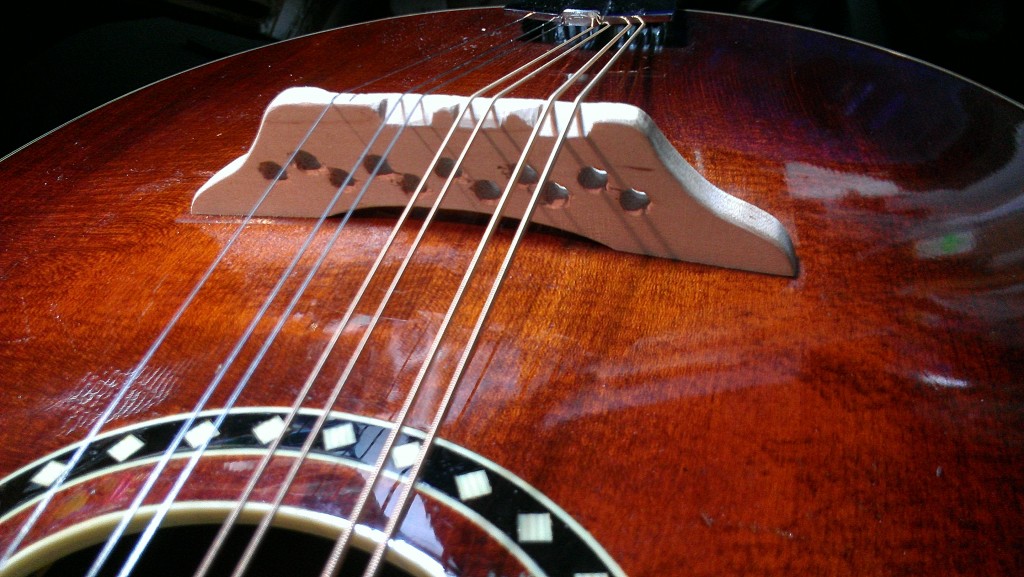
Why make your own bridge?
Most archtop mandolins come with an adjustable rosewood bridge like the black one on the left here:
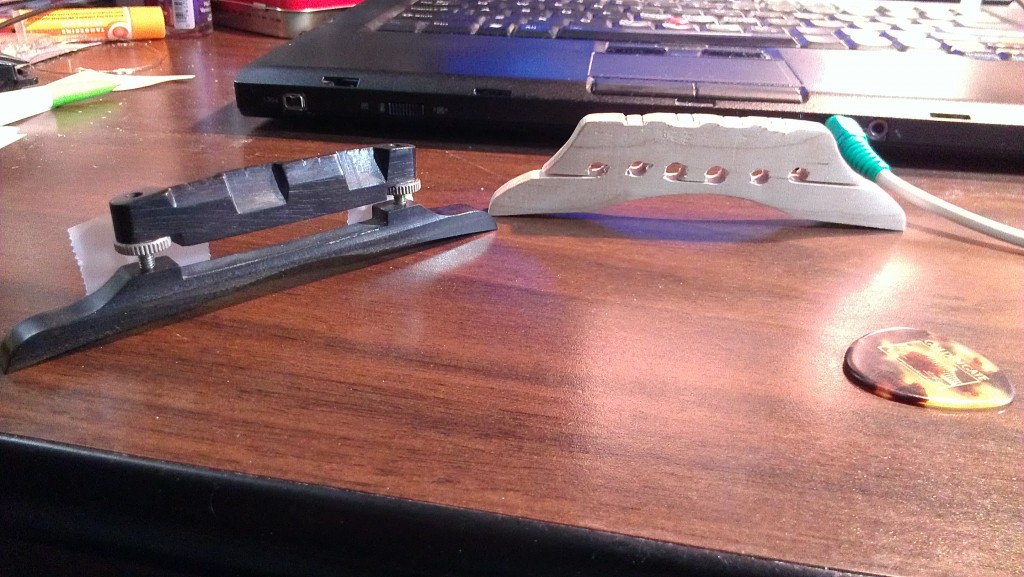
This style of bridge was already in use when Lloyd Loar designed the classic F5 and A5 models that made the Gibson Mandolin-Guitar Manufacturing Company a household name in the US strings world. Orville Gibson had already brought significant innovations to the mandolin world by borrowing techniques like the arched/carved top from the violin lutherie tradition.
(Gibson also belongs to the local history of northern NY, and I feel a sense of connection to him both through our shared homeland and through my work: he was born in Chateaugay, NY, right near where my grandfather lived; he died in Ogdensburg, NY as a resident of the St. Lawrence State Hospital (now known as the St. Lawrence Psychiatric Center), a facility with which I collaborate in my crisis hotline job; and he is buried in Malone, NY, where several of my family members live. A more tenuous connection is that I bought my first mandolin from David Nichols in Malone, NY, and David used to work at St. Lawrence Psychiatric Center. Anyway.)
Adjustable mandolin bridges are fabulous because they permit easy and quick adjustment of action (string height above the frets) by musicians. Action changes with temperature, humidity, the season, and a bunch of other factors, and it’s wonderful to be able to set things right with only a couple of minutes. Adjustable bridges are usually made of rosewood, and they’re cheap, reliable, and seen almost everywhere.
So why change them? Besides the irresistible urge to tinker?
Better sound and better volume, basically. Rosewood is a very hard, dense wood, and the adjustable bridge design involves two steel or brass bolts and two steel or brass thumbscrews. All other things being equal, you get longer sustain on bridges with lower mass, since mass damps vibration and the bridge’s purpose is to conduct vibration from the strings to the instrument’s top. (Bridges also act as frequency filters, transforming the sound and linking up different vibrational modes in different ways, but that’s a bit advanced for this page).
I bought the Eastman MD504 oval-hole mandolin shown here from my friend Tristan Henderson, who plays with Atlantic Crossing along with my Frost and Fire bandmates Viveka and Peter. It has a lovely tone, but I kept feeling like I was having to work very hard to get a decent amount of sound out of it—like it was inefficient. String changes didn’t help, so I decided to take the plunge and try out bridgemaking.
There’s a lot of neat stuff on the internet about making your own mandolin bridges, with much of the foundational work written by Red Henry. One big change is that most DIY bridge-makers use maple (like violins and the rest of the orchestral strings) rather than rosewood or ebony. Maple is a lot less dense than rosewood, although it retains similar hardness. Most DIY builders also build single-piece bridges rather than adjustable ones, optimizing for low mass instead of convenient adjustment.
There’s a lot of science involved with how one carves the bridge: how many holes, what size, where, what shape, etc. I’ve waded fairly deep into the acoustics of it, but there’s too much to write here and, in any case, I’ve built stock bridges from Red Henry’s designs for this test. But if any readers feel so moved, please get in touch and we can geek out about physics.
So, I wanted better tone. I also discovered that the original bridge on the MD504 was bending, slowly but surely, under the weight of string tension:
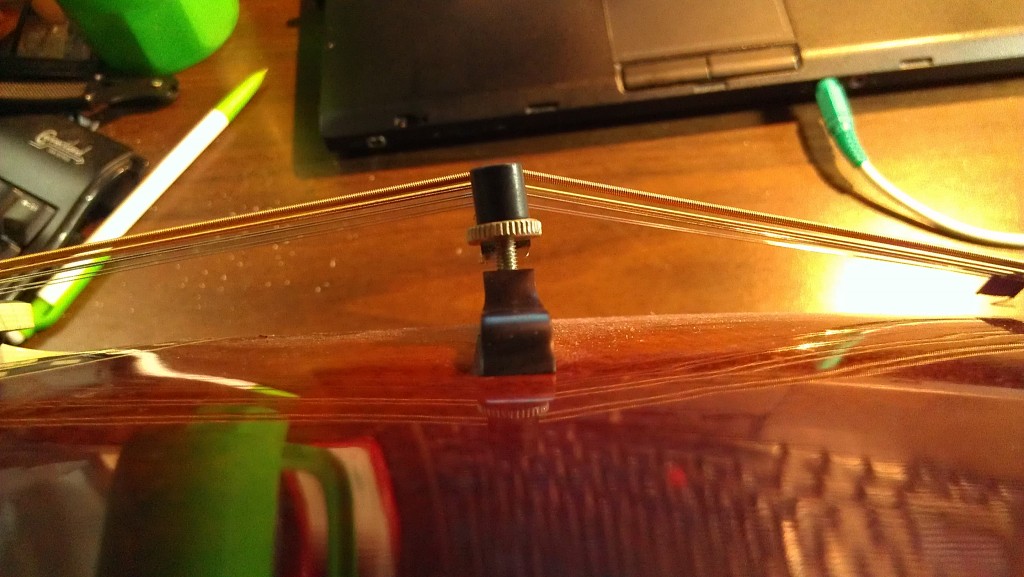
See how far forward it’s tilted, even though the feet of the bridge are flat on the mandolin top? That leads to poor tone conduction and feet that dig into the soft spruce of the instrument’s top. I was concerned that I would break the bridge if I tried to straighten it, plus I wanted a project, so I decided to try making maple bridges.
The Project Plan
I’ve been frustrated in reading other people’s mandolin bridge reports that none of them include sound files. They include great descriptions—“the new bridge dramatically improved punch and clarity”, “my bridge doubled the mando’s volume”, “I love the increase in resonance with the new bridge!”, etc.—but no way for the reader to independently compare. This drives me nuts.
So, I made a plan before I got started.
- Record the existing rosewood adjustable bridge, documenting recording position and settings to try to eliminate variables. Also use Radio Shack dB Meter to test volume.
- Recording app: ASR Sound Recorder, recording in MP4 mode
- Recording platform: HTC Rezound (Android phone) since my good audio interface got fried
- Phone/mic position: Phone sitting on the edge of my desk, mic positioned 6.5″ from front edge of mandolin, me sitting in my desk chair. Mic was level with the E strings of the mandolin.
- Automatic gain control: off.
- Record melody and chords
- Measure dB (melody, chords): I ended up not doing this because my dB meter display faced the wrong way and nobody else was home to read it for me.
- Measure sustain time (G, D, A, E): Strike the strings and measure the time until the sound was inaudible to me.
- Photograph rosewood adjustable bridge in place on mandolin
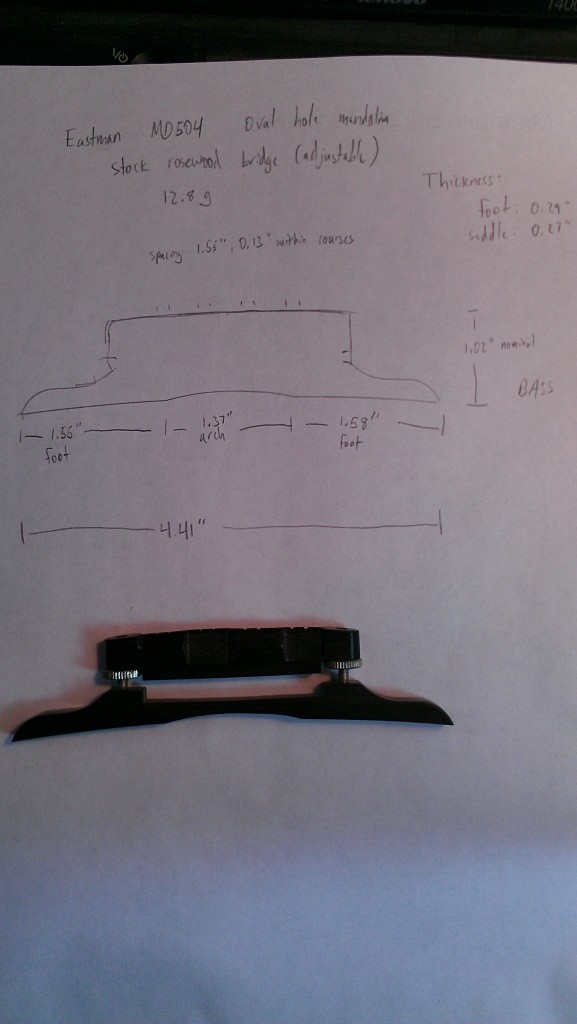
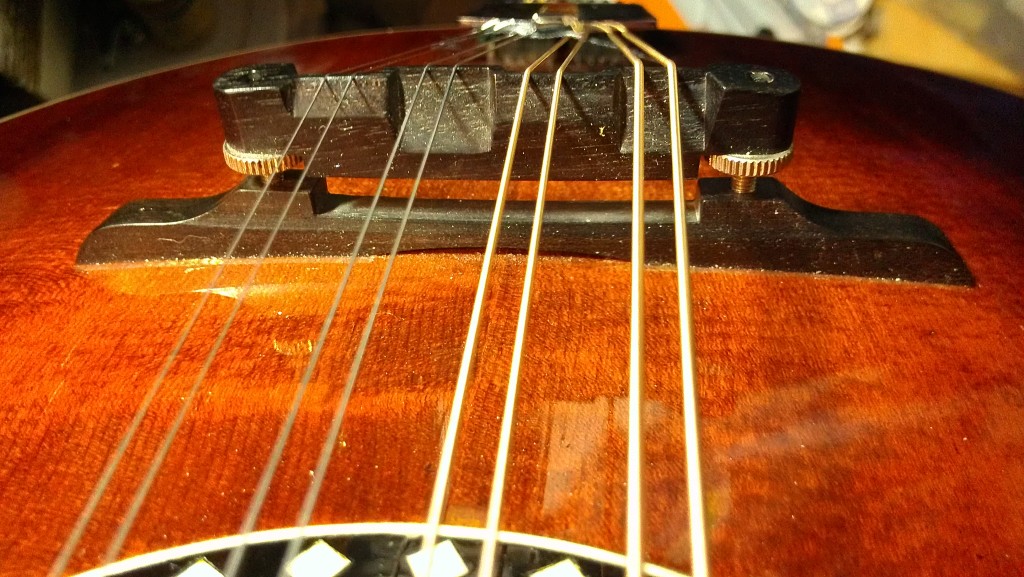
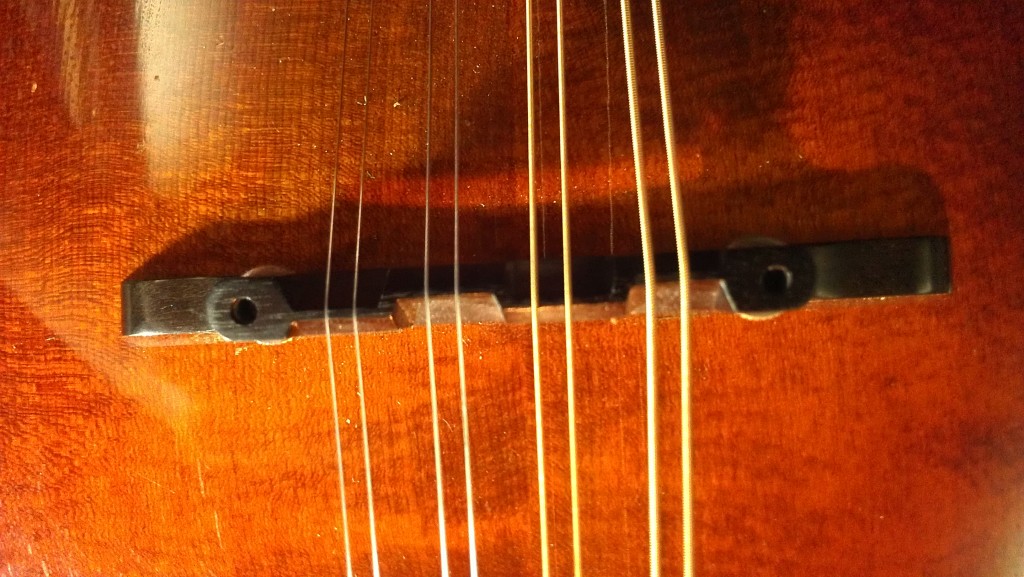
- Remove rosewood adjustable bridge
- Measure, photocopy, and document rosewood adjustable bridge (RAB), marking bass/treble sides
- Weight: 12.9 g
- Width (parallel to nut): 4.41″
- Thickness: 0.29″ at foot, 0.27″ at saddle
- Height: hard to measure, but nominally 1.02″. The MD504 has a radiused fingerboard, which makes this measurement even harder
- String spacing: 0.13″ within courses, 1.55″ total spread
- Select maple bridge design(s) and choose templates
I elected to go with two of Red Henry’s designs: an 11-hole standard bridge (pictured on the mandolin at top) and a 6-hole bridge with “wings” (the slits on the sides). The 11-hole bridge has holes drilled to 3/16″ diameter; the 6-hole has 3/16″ holes in the center and 5/32″ holes on the edges. - Cut and prepare maple bridge (MB) blanks
I used maple from a shelving scrap a friend gave me. I’m not sure what species of maple it is. Ideally, I’d make this out of quartersawn maple, but I didn’t have any—this batch is slab-sawn. This batch of maple is prone to tearing out during drilling, as you’ll see in the pictures of the 11-hole bridge.I cut the billets of maple from the larger board, marked the templates, drilled the holes, cut out the bridges with my scroll saw, cut the wings and center cutouts, then sanded and filed them. I marked the bridges with the saddle height of the original bridge, then cut them with about 1/16″ of extra wood to give myself space for setting the action. I didn’t apply a finish to these bridges. - Fit bridge(s) to mandolin
This isn’t a hard process, but it’s a labor-intensive one. The feet of the bridge need to fit the top of the mandolin precisely in order to give good tone. My approach was to rough them in with a knife, carving a U-groove into each foot (so there was a hollow surrounded by wooden edges). I darkened the bottom of the entire foot with pencil marks. Then I taped a piece of paper to which I had glued a strip of 220-grit wet/dry sandpaper onto the mandolin’s top, slackened off the strings, and placed the bridge in position.Next up, we move the bridge back and forth within a 1/2″ area hundreds of times, periodically removing it to check whether the pencil marks have been removed. It’s important to do this precisely, maintaining orientation and position. Eventually you get to the point where the bridge fits well along both feet. - Adjust intonation and setup
Break out the needle files. Here’s where we file notches for the strings to sit in and then carve “ramps”, or cutaways, into the front edges of the bridge to compensate the strings. Compensation means that we’re adjusting the scale length of the instrument (distance from saddle to nut) to compensate for the fact that, due to the different thicknesses of steel wire in the strings, they stretch different amounts when pressed down to fret different notes. This differing stretch pulls notes out of tune. Compensation aims to fix it, giving good intonation over a larger area of the fretboard. We also carve ramps on the tailpiece side of the bridge to reduce string friction over the top of the bridge. After filing string notches, lubricate them with graphite from a pencil lead. - Photograph maple bridge in place on mandolin
I forgot to photograph the 6-hole winged bridge in place; sorry. Here’s the 11-hole model after installation and testing.
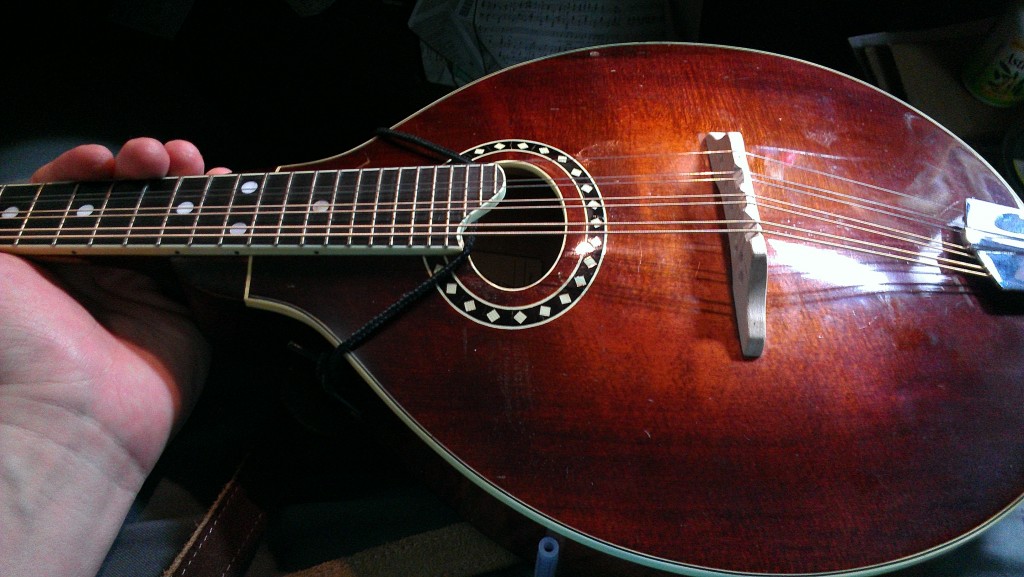
The 11-hole bridge is thinned somewhat on the tailpiece side, giving it a bit of a wedge shape. The feet are still full-size (1.12″ each), albeit somewhat smaller than the rosewood bridge’s feet (1.59″ each). - Record maple bridge(s) using same initial recording position and settings
- Record melody and chords
- Measure sustain time (G, D, A, E):
- Compare subjective feelings and recordings
How do they sound?
To let you compare without bias, I’m posting recordings of the three bridges identified only by number. There’s a key at the bottom of the page. All recordings were made using a Golden Gate stubby 1.5mm pick with a Tone Gard installed on the back of the mandolin.
I’m posting two sets of recordings: the first is the raw output of the recorder (not normalized), which shows the differences in volume and actual performance; the second is normalized audio (digitally modified so the loudest points of each track are at 0 dB), which shows more of the difference in tone.
Within each grouping, I’ve included the sustain tests (one string course at a time) and a tune, “The Torn Jacket”. On two of the recordings, I alternated between melody and chords; on the other, I forgot, so I added chords afterwards. One thing I learned: sanding and scraping mandolin bridges all night makes your playing worse than usual!
During one of these tests, I broke one of the E (highest-pitched) strings. I elected to continue recording using only one E string rather than restringing the entire instrument, since new strings have a markedly different tonal character that would have obscured the results of the experiment.
Raw audio
Sustain
- Sustain 1:
- Sustain 2:
- Sustain 3:
Torn Jacket
- Tune A:
- Tune B:
- Tune C:
Normalized audio (different numbering)
Sustain
- Sustain 11:
- Sustain 12:
- Sustain 13:
Torn Jacket
- Tune X:
- Tune Y:
- Tune Z:
Discussion
As a starting point, I was surprised by how much difference the bridges made in the mandolin’s tone, volume, and responsiveness. From the player’s perspective, all three bridges sound and feel very different. I find that the recordings under-report the differences. This could be due to the difference in position (my ears are above and behind the mandolin; the recorder was level and in front), due to difference in picking, or any of several other factors.
As expected, the maple bridges modified both tone quality and volume. Both of them are noticeably louder than the rosewood adjustable bridge, which seems predictable when you look at the measured weights for each bridge:
- Rosewood adjustable bridge: 12.9 grams
- Maple 6-hole winged bridge: 8.0 grams (38% lighter than rosewood)
- Maple 11-hole bridge: 6.5 grams (50% lighter than rosewood)
The maple bridges also have noticeably longer sustain than the rosewood bridges. (G, D, A, E, plus combined sustain times):
- Rosewood adjustable bridge: 10 s, 9 s, 8 s, 5 s. (32 s combined)
- Maple 6-hole winged bridge: 18 s, 15 s, 11 s, 8 s. (52 s, 63% longer than rosewood)
- Maple 11-hole winged bridge: 18 s, 13 s, 9 s, 4 s. (44 s, 38% longer than rosewood)
This contributes strongly to the feeling of resonance and efficiency: it’s just less work to play the mandolin with the maple bridges. A given amount of picking force yields a louder sound, which is desirable for injury prevention and comfort. The instrument feels more alive in the hands, and there’s a sense of having more tonal range to work with.
Tonally, I prefer the 11-hole maple bridge. Although its low end feels less powerful to me, I really like the clarity of its higher strings—I feel like they have more of the smoothness I associate with really nice mandolins, with less of the twang and harshness. There’s also a nice resonance to the sound, making this my clear favorite.
I like the tone of the original rosewood bridge next, with its darkness and smoothness most apparent on the normalized recordings. It has some nice variation of sound, but it’s so quiet that I find it frustrating to play. The lack of volume makes the rosewood bridge come in last, even though I like its tone.
Finally, I didn’t love the tone of the 6-hole maple bridge on this instrument. It sounds a little bit stuffy to me, with snappy harshness on the upper strings. It has lovely “thunk” on the lower strings, though. Red Henry suggests that this is a good bridge for bluegrass musicians playing F5-style instruments, and I’d believe it: the F5s I’ve played have a much more treble-heavy sound, and this bridge might lend some bass richness to them. It’s certainly an acceptable bridge even on this A5-style oval-hole mandolin. Weighing its good volume against its lesser tone, I would still pick this bridge over the rosewood adjustable one, since I think being audible is worth some theoretical tone quality.
Too Long, Didn’t Read
I prefer the DIY maple 11-hole bridge I made, both in terms of volume and tone. My next favorite is the homemade maple 6-hole bridge with wings, which gets a slight edge because of its volume although its tone is less good. The stock rosewood adjustable bridge comes in last unless you need to adjust your action a lot.
Future plans
- Improve my bridge-fitting skills, making sure I get really good contact with the top.
- Try thinner bridges, for reduced mass.
- Make more 11-hole bridges, avoiding tearout.
- Try additional woods. Red Henry reports that cherry also sounds good, and I have some nice cherry boards. I might also try making a bridge out of the salvaged floorboards from the Montpelier Capitol City Grange Hall or the Greenfield Guiding Star Grange, since it would be fun to play an instrument made from a dance floor.
- Apply some practices gleaned from the mandovoodoo method, in particular sanding/scraping the bridge until it yields identical tap tones at different points.
- Investigate whether it’s feasible to shim the bottom of the bridge feet to raise the action if necessary.
- Test whether a cyanoacrylate polymerized finish (Super Glue) increases stiffness of the wood and yields any interesting tonal qualities.
- Build bridges for other mandolins. I have an F5-style mandolin, and I have friends with mandolins. Fitting a bridge takes me an hour or two, but it’s not complicated.
- Make and sell bridge blanks for friends who want to try it themselves?
- Test Red Henry’s hypotheses about the effect of bridge foot size. He says smaller is better down to about 1″. I’m inclined to agree, based on wanting to balance structural support from the top against the desire to let the top vibrate freely.
- Make future recordings using a metronome to keep the samples more consistent.
- Test additional designs of bridges. Also, try making a maple adjustable bridge.
Sound sample key
- Sustain 1 (raw): homemade maple 11-hole bridge
- Sustain 2 (raw): homemade maple 6-hole winged bridge
- Sustain 3 (raw): rosewood adjustable bridge (stock)
- Tune A (raw): homemade maple 6-hole winged bridge
- Tune B (raw): rosewood adjustable bridge (stock)
- Tune C (raw): homemade maple 11-hole bridge
- Sustain 11 (normalized): homemade maple 6-hole winged bridge
- Sustain 12 (normalized): rosewood adjustable bridge (stock)
- Sustain 13 (normalized): homemade maple 11-hole bridge
- Tune X (normalized): rosewood adjustable bridge (stock)
- Tune Y (normalized): homemade maple 11-hole bridge
- Tune Z (normalized): homemade maple 6-hole winged bridge
The DIY maple 11-hole mandolin bridge recordings are the ones with only one E string, so they’ll have a bit more E prominence once I restring the instrument.
Thanks again to Red Henry for getting the ball rolling on these designs and providing so many ideas on his website! Check out my Mandolin Pick Comparison article if you get the chance.







Hollis, congratulations on a very thorough and well-done bridge investigation. Your systematic approach with multiple bridge designs achieved a lot that other, more hasty, experimenters might have missed. You can tell already that each mandolin may prefer a different bridge.
I do urge you to locate some quarter-sawn maple for bridges, since it may yield richer tone as you try out additional bridge designs and other mandolins. Good luck with all your experiments.
Red Henry
I wonder how black locust would work as a mando bridge. I have some laying around, air dried…Locust is a relative of the Koa.
Dave, I have tried locust for bridges (among many other woods). The sound of locust was a bit thin, so I did not pursue more experiments with that wood. However, if you make some mandolin bridges yourself, I encourage you to try locust along with any other woods you have available.
Have you tried dogwood ? I made a bridge for an f style mandolin from kiln dried dogwood . Its harder and less brittle than maple. Now I am working on one made from epay. A wood I hadn’t heard about till a few weeks ago. Its a wood that is mostly used for outdoor decks. I think its guaranteed by one supplier to hold up for 75 years of outdoor use. So I figured it might make a tough bridge.
Hi Jerry!
Nope, I’ve never tried dogwood–don’t know that I’ve ever even seen dogwood in a lumber yard, and I don’t think we have local dogwood trees in northern NY. I’d be happy to be proven wrong, though!
Assuming that you’re talking about ipe (pronounced EE-pay, http://www.wood-database.com/lumber-identification/hardwoods/ipe/ ), I’ve used it for making jewelry but not for making mandolin bridges. On first guess, I would expect it to be quieter than a maple bridge (because it’s much denser than maple) unless you scaled down the dimensions (which you might be able to do because it has greater crush resistance and strength).
I’d love to hear sound files of your ipe and dogwood bridges–if you send them to me, I can host them here if you don’t have your own web hosting.
Thanks for writing in!
I recall trying redbud (thin-sounding bridge), but not dogwood. Give it a try, and post the results. Let us know how epay sounds, too.
I have also heard that osage orange (hedge apple) is a very hard tough wood. Have you tried that yet ? I just remembered I think I have a piece of it . I might try a bridge from it if I get bored after I finish the one from the epay .
By the way the dogwood bridge works well. I’ve been using it for a couple of years now. It gives the mandolin a deep rich tone. It might look a little strange being a light color against the darker top , but I reckon I can pick with my eyes closed. Just kiddin I play every week at our chuch and nobody has ever mentioned the difference in the colors.
Yeah, people never comment on my maple bridge’s appearance (which I left blonde) unless I point it out to them.
Seems like the ipe is more brittle than I thought it would be. It carves and sands like ebony but I guess I will go ahead and see how it comes out . If I’m not happy with it I’ll be looking for a chunck of maple and see what I come up with. Thanks Hollis for all the info and all the work you’ve done to help others. Sounds like you’ve put several hundred hours into this already . Keep pickin and whittlin.!
I had a graphite/carbon bridge (top half only) on a 1975 Ibanez mando for years. VERY loud, but treble was harsh. I never got around to trying bone inserts to smooth out the high end. Last year I went back to the all rosewood top and preferred it. I have a new Eastman 515 which has not really opened up yet. I may try maple. I got the graphite idea after spending a little time with Frank Wakefield, who used fiberglass/epoxy bridges. He also is rumored to have baked his entire mandolin in the oven. Yikes.
Would you say brass would be a good resonator of sound for a bridge?
I think that a brass bridge would produce a harsh, tinny sound with very little volume.
Just want to tell you that your research seems through, & you spent a lot of time on it. The one thing I’d like to tell you is that putting graphite on the bridge slots amounts to putting grease on a tire. The whole idea of the bridge is to transfer vibrations from the string to the belly , & it cannot do that if the string is not grabbing the bridge. The graphite should only be applied to the nut, where you want the string to slide during playing & tuning up.
I loved this article!
I have some pecan wood. It is VERY hard. I am in the process of making two bridges one maple and one ebony. What do think about the pecan?